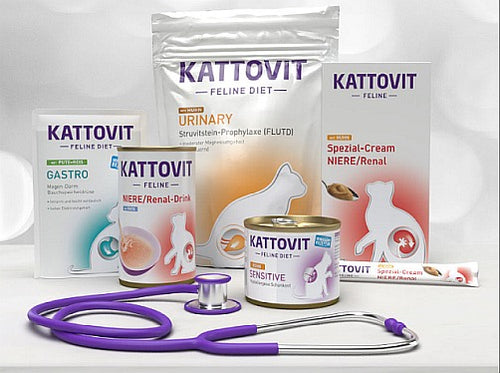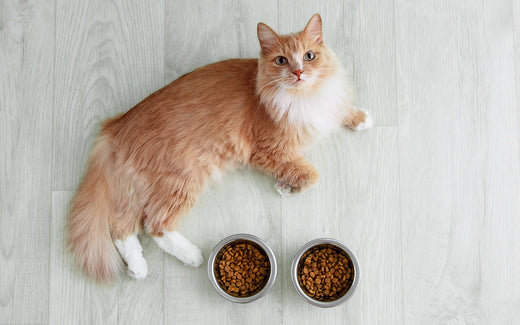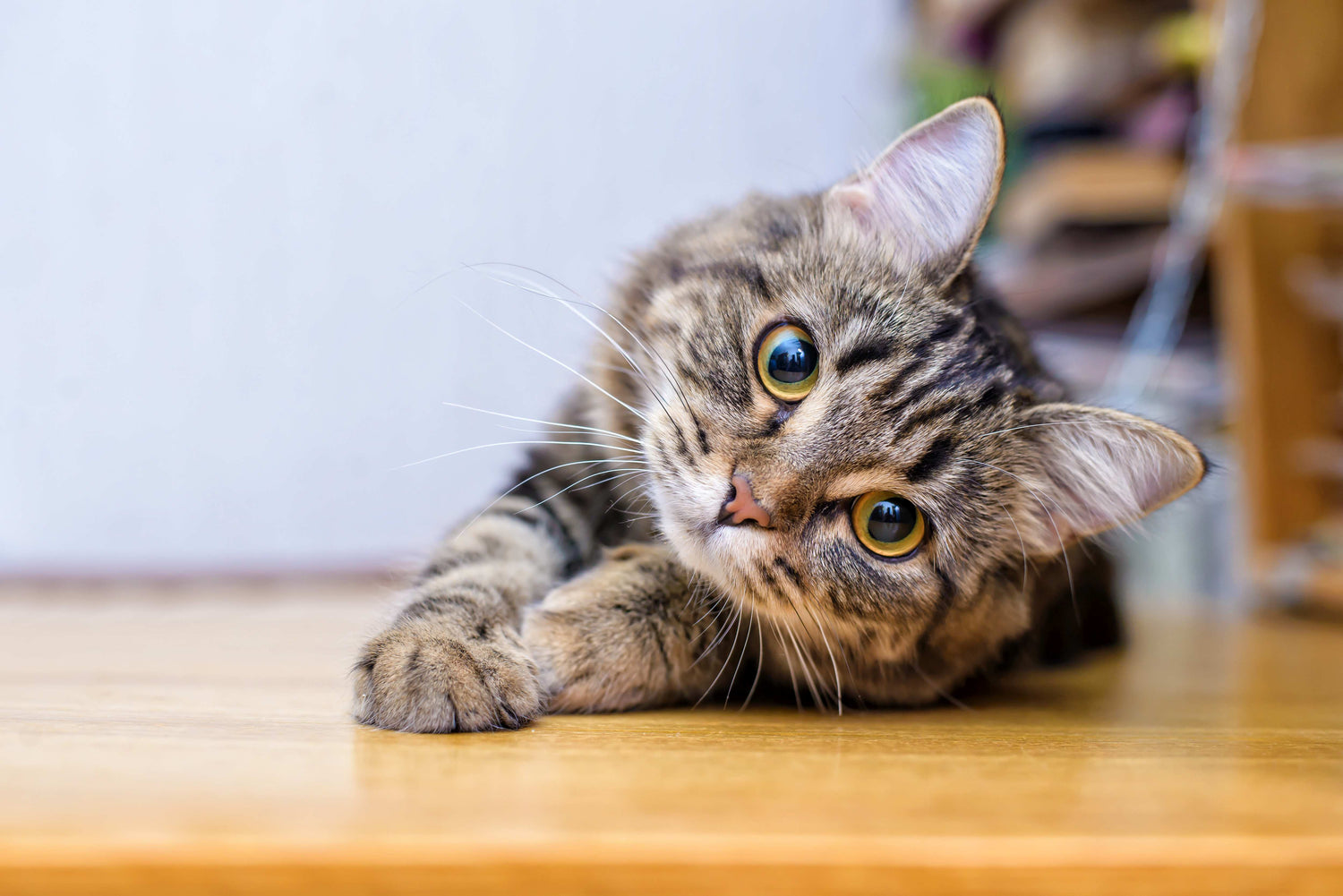Food Allergy and Food Intolerance in Cats
Anyone who has experienced it knows only too well how these worries feel: When your kitten is struggling with digestive problems, skin rashes or even shortness of breath, you often feel at a loss. The solution often lies in the food. Because the thing that is supposed to be good for our four-legged friends and provide them with nutrients and energy can sometimes also be responsible for them feeling bad - for example, if they have a food allergy or intolerance. Our guide will therefore show you how allergies and intolerances manifest themselves, what the causes may be and how you can tackle them.
What is the difference between allergy and intolerance?
In common parlance, the terms allergy and intolerance are often used synonymously. Strictly speaking, these are two different illnesses - even if the symptoms are often similar and make it difficult to clearly classify them. So what are the parallels and what are the key differences?
First of all, both – food allergy and food intolerance – have one thing in common: The cat reacts to the food intake with physical symptoms of illness . Even one ingredient that is not agreeable to the cat is enough to massively disrupt digestion or other physical functions and cause discomfort .
The difference between the two diseases, however, lies in the way the animal reacts to the respective ingredient in the food. And this does not mean the symptoms that you as the owner can see with the naked eye, but the processes that the body goes through. In the case of a food allergy, the immune system perceives the affected food ingredient as a pathogen and fights the intruder with all means at its disposal. If, on the other hand, your cat has a food intolerance , this is a metabolic disorder . This ensures that some ingredients cannot be processed, or at least not properly . This leads to a disruption in the digestive process and the resulting symptoms.
Whether it is an allergy or intolerance, one thing is certain: to put an end to the suffering, a change in diet is necessary. For sensitive cats, particularly well-tolerated food is recommended, which not only tastes good and is filling, but is also gentle on the stomach.
Before we look at the right diet and other treatment options, we first need a diagnosis . This should always be done by your trusted vet , but it starts at home. After all, you are the closest to your pet - and you will be the first to notice that something is wrong.
[Sensitive]
These symptoms indicate a food allergy or intolerance
Detecting a food allergy or intolerance is not easy. Unlike other diseases such as a gastrointestinal infection, there are numerous various symptoms Whether itching, hair loss, diarrhea and vomiting or Loss of appetite : Many reactions and behaviors can indicate that your animal is not able to tolerate the food, or is even allergic to it. In order to make a definitive diagnosis of food allergy or food intolerance, further examinations by a veterinarian are required after an initial suspicion.
Basically, the symptoms that indicate a food intolerance or an allergic reaction can be divided into four core areas: digestion, skin and coat, your cat's personality and respiratory problems .
digestive problems
The classic symptoms include abnormalities related to the gastrointestinal tract . These include:
- Vomit
- Diarrhea
- flatulence
- stomach pain
- constipation (rather rare)
skin and coat problems
The second category of symptoms, which can also indicate an allergic reaction or intolerance, includes Changes in the skin and coat area . For example, if your cat is struggling with one or more of the following symptoms, this may indicate that the food is not agreeing with her.
- Itching, especially on the head and paws
- inflammation and redness
- flaking and dry skin
- hair loss (independent of coat change)

personality changes
The third area that such a disease can affect concerns the behavior and appearance of your animal. Even if changes in behavior are sometimes difficult to determine and sometimes just depend on mood or phase: In some cases, allergies and intolerances can cause changes in your pet's personality. The corresponding signs should not be taken lightly:
- loss of appetite
- apathy and even indifference
- weight loss and even emaciation
restriction of the airways
An allergy or intolerance to food can sometimes take on drastic consequences. For example, food intolerance can also manifest itself in the form of respiratory symptoms: If your cat is having difficulty breathing, its mouth is mostly open and you can see the upper body rising and falling, then it is most likely suffering from respiratory distress:
- irritation of the respiratory tract
- shortness of breath
Finally, it should be noted that a list of potential symptoms alone is never enough to determine without a doubt that your four-legged friend is suffering from a food allergy or intolerance. However, it can still be helpful to get an initial feeling for what is wrong with your cat - especially if you already have a suspicion. For example, if one of the above signs occurs after you have changed food manufacturers or perhaps tried a different variety to offer the gourmet a little variety in terms of culinary options? Then you need to pay attention.
What are the causes of food allergies?
The causes are similar to the symptoms. Allergies and intolerances can be caused by all kinds of foreign substances . They can also come on very suddenly. A food intolerance - whether with or without an immune response - does not necessarily have to accompany your pet from a young age or be related to a change in food . Even cats that have been real fish lovers for years and couldn't get enough of their scaly friends can suddenly react to it.
However, there are a number of food ingredients that are particularly known for their ability to trigger allergies and intolerances. Animal and grain products in particular are considered to be the cause of intolerances. In cats, various protein sources and carbohydrates in particular can be classified as real allergen all-rounders:
- proteins
- egg
- beef
- lamb
- pork
- Fish
- dairy products
- soy
- carbohydrates
- Wheat
- corn
- rice
There are also other ingredients that are often found in industrial food : so-called preservatives . Although they are rarely the cause of intolerances, they act as accelerators and thus cause symptoms to appear more frequently. The same applies to some selected medications and, not least, to genetic predispositions. Due to breeding, intolerances occur more frequently in some cat breeds than in others.
How do I know what my cat is reacting to?
If your cat is showing symptoms , you should always see a vet . While self-diagnosis is often the first step in the right direction, it can also mislead you in your concern or lead you to jump to conclusions and actions. That's why nothing beats a professional assessment - so see your trusted vet quickly before the condition worsens.
Since the symptoms of intolerance, as already described, can serve as indicators of various cat diseases, the veterinarian usually first rules out other diseases. Only then does the search for the exact cause begin: What foreign substance is your darling reacting to?
In general, two methods of diagnosis have proven effective for allergies and intolerances: the allergy test at the doctor and the food test at home .
allergy test
Allergy tests are carried out in veterinary practices and are designed to identify as quickly as possible which substance the body classifies as an intruder and tries to fight off. A distinction is made between skin tests - also known as intracutaneous tests - and blood tests.
During the skin test, common allergens are gradually injected under the skin - in the case of an allergy, swelling and discoloration will occur at the injection site. Don't worry - your kitten will be calmed down beforehand and will sleep peacefully. However, if the symptoms of the illness are itching or skin irritation, additional irritation through the skin test should be avoided.
The blood test works as follows: The doctor takes a blood sample and tests the antibodies it contains for various allergens. However, it can happen that the results are not particularly meaningful.
feed test
In addition to the classic allergy test, the concept of an exclusion diet - also known as an elimination diet in technical jargon - is also an option. After consulting your vet, you can use a food test lasting several weeks in your own home to find out which component of the cat food triggers an allergy. Your cat will be put on a strict diet . This may be a challenge for both the sweet tooth and you, but in the end it brings clarity and increases well-being - and that is probably the best reason to stick with it. The whole thing works like this:
elimination phase
1. Give your cat a previously unknown cat food . It is important that not only the food - i.e. the brand and type - is new, but also the protein and carbohydrate sources it contains. You can therefore use less common types of meat such as horse or venison as a protein source. Many cats are also less allergic to proteins from poultry. So the solution to your problems may not be far off: simply switching to pure poultry can help, so that more exotic monoproteins such as kangaroo and the like may not even be necessary. Potatoes, for example, are also suitable for covering carbohydrates.
2. Variety in feeding and unplanned snacks are taboo . This is harder than you think – but essential for the elimination diet.
3. After twelve weeks at the latest, you should see a clear improvement . If the symptoms subside or, in the best case, even disappear completely, move on to the next phase .
provocation phase
4. After completing the elimination phase , return to a protein or carbohydrate source that you have been feeding your cat before. Here, too, start by switching to a single type of meat that was on your cat's menu before the change - for example, beef or fish.
5. If the familiar symptoms return - this usually happens within two weeks - then the food test was successful. You have identified which component your cat cannot tolerate and can do without it from now on.
repetition phase
6. It usually takes some time to identify all the substances that trigger allergies. You can do this by repeating the process and testing different ingredients one by one. This way you can be sure that you are eliminating all sources of danger from the diet from now on. However, you should be careful here. It is best to always consult your veterinarian, because the following applies:
Every animal is different. Some cats react more quickly, others less quickly. Some candidates with sensitive stomachs may find the exclusion diet bitter. A rapid change in diet means a lot of stress for your cat. Therefore, the change should be made gradually and gently. Read this article to find out how to best approach the change in diet and which tricks can help.
If you are otherwise coping extremely well with the restricted diet and your cat is not lacking anything, repeating the elimination diet is not necessarily necessary.
Tips and Tricks
Finally, here are a few tips to maximize the chances of success of the feed change and to bring about rapid improvement:
- Hypoallergenic food:
Classic canned food is not an option for the exclusion diet - the ingredients are often not clearly stated. Instead, we recommend using hypoallergenic cat food - this relieves the metabolism, the immune system and the digestive tract and uses particularly well-tolerated and simple ingredients. - house arrest:
Many cats live in two worlds: within their own four walls and exploring outdoors. For cats that go outside, there is a curfew during the elimination diet. This is the only way to ensure that your sweet tooth sticks to his meal plan. - No additional products:
If possible, you should also avoid giving additional vitamins, dental rinses and the like. It is best to consult your veterinarian about this. - Perseverance:
Admittedly, it takes some determination to stick to this diet. Even if you see improvement quickly, you should keep going. After all, this time also serves as a rest period for your cat to recover from the symptoms.
How can I help my cat?
There is hardly anything that hurts more than having to watch your own pet suffer. That is why it is all the more important to know how you can help your cat with the symptoms of a food intolerance or allergy and pave the way for her to return to a happy life as a cat.
Off to the vet
Step 1 is always to go to the vet . And it's better to go too often than too little. After all, cats like to hide when they're not feeling well, and the intensity of their symptoms isn't always immediately apparent to you as the owner. A doctor can help to make a diagnosis , identify the triggers and advise you on treatment .
treatment of disease and symptoms
A food allergy - the disease itself - is treated by changing the diet . Once you have found out what your cat is allergic to or cannot tolerate, the symptoms should be eliminated by excluding the food in question from the diet and adding alternatives .
Our SENSITIVE range makes exactly that possible: The hypoallergenic cat food gentle on the stomach and is on the needs of sensitive cats with food allergies and intolerances. This also includes sensitive gourmets happy again – not only during the elimination diet, but also long afterward.
Whether and to what extent treatment of the individual symptoms is necessary depends on the condition of your cat. A visit to the veterinarian with a thorough examination of the health condition will help here. After all, diarrhea and Vomit For example, it can lead to massive fluid and weight loss, which must be treated quickly. In some cases, additional treatment by a doctor may be necessary to get your cat back on its feet.









